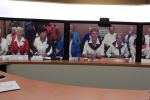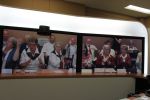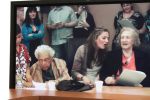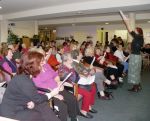
The Young At Heart choir from Almere
This week I attended an extraordinary international singalong in which two choirs of older people, one in Melbourne, the other in Amsterdam, sang to each other as if they were in the same room. I was in London, and I felt I was there (wherever ‘there’ was) too.
The event was made possible by video technology that has been designed for international business meetings. Sitting round a semicircular table, facing wraparound screens, we experienced the presence of the other participants as if they were on the other side of a round table.
The whole thing came about after a meeting between Kevin Johnson of Cisco and Pamela Bruder of the Emmy Monash Aged Care home in Melbourne. Pamela’s work demonstrates the role music can play in bridging generations and in enabling people with different levels of need for care to mix as equals. Cisco is nearing the end of a 6-month experiment in the town of Almere, in the Netherlands, to see whether video technology can extend the participation of older people. Using video conferencing and Flip cameras, people who wouldn’t be able to get across the city can, for example, now take an exercise class. Or indeed, join the Young At Heart Choir, which rehearses in two places at once.
The singers from Emmy Monash – one of whom lives in the high care unit, two in the dementia-specific wing, while two more are registered blind (you couldn’t tell who was which) – sang haunting Hebrew songs with some of the school students who rehearse with them. The Almere choir sang pop medleys, including The Twist because, in the words of their charismatic choirmaster, Gerard Poot, ‘a lot of people here have new hips.’ Kevin and I also sang along, where we knew the words. He has rather a good voice. I don’t. Poot said he had been conducting for 30 years, and ‘I have never experienced anything like this. It’s really great, a once in a lifetime experience.’
The curious thing about the morning was that it was both mundane and exhilarating. At one level it was just a group of people singing together; at another, the accents kept reminding you that half of them were on the other side of the world. It did push the technology to its limits – ‘This is more people than I’ve ever seen in a TelePresence room’ Kevin acknowledged, and there may be a reason for that: the technology is set up for discussion rather than performance. But it was a powerful experience all the same, and everyone wanted to do it again.
‘One of our ladies who lives in the dementia wing, to my surprise, mentioned it the next day,’ Pamela reported afterwards. ‘She was describing it to one of our nurses, saying how beautiful it was, and how the people in Amsterdam seemed so close, she felt that she could reach out and touch them.’


 One resident no longer speaks, but he still sings. Another’s memory loss and condition mean that he can no longer read. But he has been singing since he was a child and knows how to harmonise and sustain a note; he is one of the finest singers in the choir.
One resident no longer speaks, but he still sings. Another’s memory loss and condition mean that he can no longer read. But he has been singing since he was a child and knows how to harmonise and sustain a note; he is one of the finest singers in the choir. Students from local schools also come in on a regular basis. ‘The choir is an icebreaker. Often kids will come in to a high care facility and they don’t know where to look: there’s someone with a paralysed limb, or repeating the same thing over and over. But singing is a neutraliser. You can’t tell what people are capable of by looking at them. We sit the students two between residents, and we often run out of songbooks, so people have to share. You can find a person from the high care area who’s had a stroke but is cognitively unimpaired helping someone from the low care area. It’s hugely important never to make assumptions about what people are capable of because they carry a label – “high care” or “short-term memory loss.”’
Students from local schools also come in on a regular basis. ‘The choir is an icebreaker. Often kids will come in to a high care facility and they don’t know where to look: there’s someone with a paralysed limb, or repeating the same thing over and over. But singing is a neutraliser. You can’t tell what people are capable of by looking at them. We sit the students two between residents, and we often run out of songbooks, so people have to share. You can find a person from the high care area who’s had a stroke but is cognitively unimpaired helping someone from the low care area. It’s hugely important never to make assumptions about what people are capable of because they carry a label – “high care” or “short-term memory loss.”’
 Seventy per cent of people aged over 65 in the UK have never used the internet. In a time when personal communication, social networking and the supply of services is being revolutionized by technology, older people are being largely excluded. The Government is concerned enough about this to have introduced a panoply of initiatives to overcome digital exclusion, many of which are aimed directly at older people. But the dominant reason older people say they don’t take up or haven’t sought access to the internet is that they don’t feel they need it.
Seventy per cent of people aged over 65 in the UK have never used the internet. In a time when personal communication, social networking and the supply of services is being revolutionized by technology, older people are being largely excluded. The Government is concerned enough about this to have introduced a panoply of initiatives to overcome digital exclusion, many of which are aimed directly at older people. But the dominant reason older people say they don’t take up or haven’t sought access to the internet is that they don’t feel they need it.